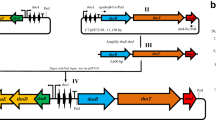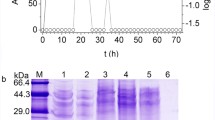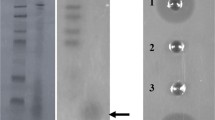Abstract
Thurincin H, a bacteriocin produced by Bacillus thuringiensis, exhibits antibacterial activity against Gram-positive and Gram-negative bacteria. While much is known about its expression and antimicrobial spectrum, its hemolytic property has yet to be established. In this study, thurincin H was produced in a plasmid-free acrystalliferous strain of B. thuringiensis (Bt Cry−B) that naturally lacked antimicrobial and hemolytic activities. When grown in Tryptic Soy Broth (TSB), the bacteriocin’s maximal production in Bt Cry−B harboring the thurincin H genetic cluster (Bt Cry−B/pThur) was observed at 24 h. Thurincin H was purified as a sole peptide of ~5 kDa using three purification steps, i.e., salt precipitation, ultrafiltration, and gel filtration chromatography. The bacteriocin showed inhibitory activity against B. cereus (5631 U), Bt Cry−B (8827 U), E. faecium wild type (11,197 U), and E. faecium ATCC 19,434 (6950 U), but not against Bt Cry−B/pThurH and Bt Cry−B/pThurHΔThnA. In addition, a minimum inhibitory concentration (MIC) of 5.0 μg/mL against B. cereus 183 was observed. In silico predictions suggested that thuricin H lacks hemolytic activity, which was validated in vitro using 4 × the MIC, i.e., 20 μg/ml. Our data lay a foundation for the potential safe use of thurincin H as an antibacterial peptide for medical use, in food products, and for expression in probiotic bacteria.





Similar content being viewed by others
Data Availability
All raw data for the statements presented here are available from the authors TOR, JEBC at the University of Guanajuato, México.
References
Pasupuleti M, Schmidtchen A, Malmsten M (2012) Antimicrobial peptides: key components of the innate immune system. Crit Rev Biotechnol 32(2):143–171. https://doi.org/10.3109/07388551.2011.594423
Cotter PD, Ross RP, Hill C (2013) Bacteriocins - a viable alternative to antibiotics? Nat Rev Microbiol 2:95–105. https://doi.org/10.1038/nrmicro2937
Kumariya R, Garsa AK, Rajput YS, Sood SK, Akhtar N, Patel S (2019) Bacteriocins: Classification, synthesis, mechanism of action and resistance development in food spoilage causing bacteria. Microb Pathog 128:171–177. https://doi.org/10.1016/j.micpath.2019.01.002
Hammond K, Lewis H, Halliwell S, Desriac F, Nardone B, Ravi J, Hoogenboom BW, Upton M, Derrick JP, Ryadnov MG (2020) Flowering poration-a synergistic multi-mode antibacterial mechanism by a bacteriocin fold. iScience. 23(8):101423. https://doi.org/10.1016/j.isci.2020.101423
Bacalum M, Radu M (2015) Cationic antimicrobial peptides cytotoxicity on mammalian cells: an analysis using therapeutic index integrative concept. Int J Pept Res Ther 21(1):47–55. https://doi.org/10.1007/s10989-014-9430-z
Cesa-Luna C, Alatorre-Cruz J-M, Carreno-Lopez R, Quintero-Hernandez V, Baez A (2021) Emerging applications of bacteriocins as antimicrobials, anticancer drugs, and modulators of the Gastrointestinal Microbiota. Pol J Microbiol 70(2):143–159. https://doi.org/10.33073/pjm-2021-020
Verma DK, Thakur M, Singh S, Tripathy S, Gupta AK, Baranwal D, Patel AR, Shah N, Utama GL, Niamah AK, Chávez-González ML, Flores-Gallegos C, Aguilar CN, Srivastav PP (2022) Bacteriocins as antimicrobial and preservative agents in food: Biosynthesis, separation and application. Food Biosci 46:101594. https://doi.org/10.1016/j.fbio.2022.101594
Raymond B, Federici BA (2017) In defense of Bacillus thuringiensis, the safest and most successful microbial insecticide available to humanity - a response to EFSA. FEMS Microbiol Ecol 93(7):fix084. https://doi.org/10.1093/femsec/fix084
Malovichko YV, Nizhnikov AKS (2019) Repertoire of the Bacillus thuringiensis virulence factors unrelated to major classes of protein toxins and its role in specificity of host-pathogen interactions. Toxins (Basel) 11(6):347. https://doi.org/10.3390/toxins11060347
Barboza-Corona JE, Vázquez-Acosta H, Bideshi DK, Salcedo-Hernández R (2007) Bacteriocin-like inhibitor substances production by Mexican strains of Bacillus thuringiensis. Arch Microbiol 187(2):117–126. https://doi.org/10.1007/s00203-006-0178-5
Pacheco-Cano RD, de la Fuente-Salcido NM, Salcedo-Hernández R, León-Galván MF, Bideshi DK, Hernández-Guzmán G, Barboza-Corona JE (2014) Characterization, N-terminal sequencing and classification of Tolworthcin 524: a bacteriocin produced by Bacillus thuringiensis subsp. tolworthi. Microbiol Res 169(12):948–953. https://doi.org/10.1016/j.micres.2014.04.005
Shin JM, Gwak JW, Kamarajan P, Fenno JC, Rickard AH, Kapila YL (2016) Biomedical applications of nisin. J Appl Microbiol 120(6):1449–1465. https://doi.org/10.1111/jam.13033
Rea MC, Dobson A, O’Sullivan O, Crispie F, Fouhy F, Cotter PD, Shanahan F, Kiely B, Hill C, Ross RP (2011) Effect of broad- and narrow-spectrum antimicrobials on Clostridium difficile and microbial diversity in a model of the distal colon. Proc Natl Acad Sci USA 108(Suppl 1):4639–4644. https://doi.org/10.1073/pnas.1001224107
De la Fuente-Salcido NM, Casados-Vázquez LE, Barboza-Corona JE (2013) Bacteriocins of Bacillus thuringiensis can expand the potential of this bacterium to other areas rather than limit its use only as microbial insecticide. Can J Microbiol 59(8):515–522. https://doi.org/10.1139/cjm-2013-0284
Gutiérrez-Chávez AJ, Martínez-Ortega EA, Valencia-Posadas M, León-Galván MF, de la Fuente-Salcido NM, Bideshi DK, Barboza-Corona JE (2016) Potential use of Bacillus thuringiensis bacteriocins to control antibiotic-resistant bacteria associated with mastitis in dairy goats. Folia Microbiol (Praha) 61(1):11–19. https://doi.org/10.1007/s12223-015-0404-0
Oros-Flores ZS, Casados-Vázquez LE, Bideshi DK, Salcedo-Hernández R, Barboza-Corona JE (2018) Co-synthesis of kenyacin 404 and heterologous thurincin H enhances the antibacterial activity of Bacillus thuringiensis. Biotechnol Lett 40(11–12):1531–1540. https://doi.org/10.1007/s10529-018-2601-9
Nazari M, Smith DL (2020) A PGPR-produced bacteriocin for sustainable agriculture: a review of thuricin 17 characteristics and applications. Front Plant Sci 11:916. https://doi.org/10.3389/fpls.2020.00916
Lee H, Churey JJ, Worobo RW (2009) Biosynthesis and transcriptional analysis of thurincin H, a tandem repeated bacteriocin genetic locus, produced by Bacillus thuringiensis SF361. FEMS Microbiol Lett 299(2):205–213. https://doi.org/10.1111/j.1574-6968.2009.01749.x
Casados-Vázquez LE, Bideshi KD, Barboza-Corona JE (2017) The thnR gene is a negative transcription regulator of the thurincin H genetic cassette in Bacillus thuringiensis subsp. morrisoni. Arch Microbiol 99(2):385–390. https://doi.org/10.1007/s00203-016-1298-1
Casados-Vázquez LE, Bideshi DK, Barboza-Corona JE (2018) Regulator ThnR and the ThnDE ABC transporter proteins confer autoimmunity to thurincin H in Bacillus thuringiensis. Antonie Van Leeuwenhoek 11(12):2349–2360. https://doi.org/10.1007/s10482-018-1124-7
Gaona-Mendoza AS, Barboza-Corona JE, Casados-Vázquez LE (2020) Improving the yields of thurincin H in a native producer strain. Antonie Van Leeuwenhoek 113(7):1061–1066. https://doi.org/10.1007/s10482-020-01408-3
Sit CS, van Belkum MJ, McKay RT, Worobo RW, Vederas JC (2011) The 3D solution structure of thurincin H, a bacteriocin with four sulfur to α-carbon crosslinks. Angew Chem Int Ed Engl 50(37):8718–8721. https://doi.org/10.1002/anie.201102527
Mozolewska MA, Sieradzan AK, Niadzvedstki A, Czaplewski C, Liwo A, Krupa P (2017) Role of the sulfur to α-carbon thioether bridges in thurincin H. J Biomol Struct Dyn 35(13):2868–2879. https://doi.org/10.1080/07391102.2016.1234414
Gaona-Mendoza AS, Bravo-Rivas MC, Barboza-Corona JE, Massange-Sánchez JA, Casados-Vázquez LE (2021) Expression of thurincin H, ChiA74 and Cry proteins at the sporulation phase in Bacillus thuringiensis HD1. J Appl Microbiol. https://doi.org/10.1111/jam.15434
Delgado A, Brito D, Fevereiro P, Tenreiro R, Peres C (2005) Bioactivity quantification of crude bacteriocin solutions. J Microbiol Meth 62:121–124. https://doi.org/10.1016/j.mimet.2005.01.006
Reyes-Ramírez A, Ibarra JE (2008) Plasmid patterns of Bacillus thuringiensis type strains. Appl Environ Microbiol 74(1):125–129. https://doi.org/10.1128/AEM.02133-07
Haider SR, Reid HJ, Sharp BL (2012) Tricine-SDS-PAGE. Methods Mol Biol 869:81–91. https://doi.org/10.1007/978-1-61779-821-4_8
Merril CR, Goldman D, Sedman SA, Ebert MH (1981) Ultrasensitive stain for proteins in polyacrylamide gels shows regional variation in cerebrospinal fluid proteins. Science 211(4489):1437–1438. https://doi.org/10.1126/science.6162199
Wiegand I, Hilpert K, Hancock RE (2008) Agar and broth dilution methods to determine the minimal inhibitory concentration (MIC) of antimicrobial substances. Nat Protoc 3(2):163–175. https://doi.org/10.1038/nprot.2007.521
Dreyer L, Smith C, Deane SM, Dicks LMT, van Staden AD (2019) Migration of bacteriocins across gastrointestinal epithelial and vascular endothelial cells, as determined using in vitro simulations. Sci Rep 9(1):11481. https://doi.org/10.1038/s41598-019-47843-9
Zhao Q, Shi Y, Wang X, Huang A (2020) Characterization of a novel antimicrobial peptide from buffalo casein hydrolysate based on live bacteria adsorption. J Dairy Sci 103(12):11116–11128. https://doi.org/10.3168/jds.2020-18577
Evans BC, Nelson CE, Yu SS, Beavers KR, Kim AJ, Li H, Nelson HM, Giorgio TD, Duvall CL (2013) Ex vivo red blood cell hemolysis assay for the evaluation of pH-responsive endosomolytic agents for cytosolic delivery of biomacromolecular drugs. J Vis Exp 73:e50166. https://doi.org/10.3791/50166
Win TS, Malik AA, Prachayasittikul V, Wikberg JES, Nantasenamat C, Shoombuatong W (2017) HemoPred: a web server for predicting the hemolytic activity of peptides. Future Med Chem 9(3):275–291. https://doi.org/10.4155/fmc-2016-0188
Sereena MC, Sebastian D (2020) Evaluation of anticancer and anti-hemolytic activity of Azurin, a novel bacterial protein from Pseudomonas aeruginosa SSj. Int J Pept Res Ther 26:459–466. https://doi.org/10.1007/s10989-019-09851-1
Hetz C, Bono MR, Barros LF, Lagos R (2002) Microcin E492, a channel-forming bacteriocin from Klebsiella pneumoniae, induces apoptosis in some human cell lines. Proc Natl Acad Sci U S A 99(5):2696–2701. https://doi.org/10.1073/pnas.052709699
Begde D, Bundale S, Mashitha P, Rudra J, Nashikkar N, Upadhyay A (2011) Immunomodulatory efficacy of nisin-a bacterial lantibiotic peptide. J Peptide Sci 17:438–444. https://doi.org/10.1002/psc.1341
Vaucher RA, Teixeira ML, Brandelli A (2010) Investigation of the cytotoxicity of antimicrobial peptide P40 on eukaryotic cells. Curr Microbiol 60(1):1–5. https://doi.org/10.1007/s00284-009-9490-z
Ruiz-De Anda D, Casados-Vázquez LE, Ozuna C (2022) The synergistic effect of thurincin H and power ultrasound: an alternative for the inactivation of Listeria innocua ATCC 33090 and Escherichia coli K-12 in liquid food matrices. Food Control. https://doi.org/10.1016/j.foodcont.2021.108778
Benitez-Chao DF, Leon-Buitima A, Lerma-Escalera JA, Morones-Ramirez JR (2021) Bacteriocins: An overview of antimicrobial, toxicity, and biosafety assessment by in vivo models. Front Microbiol 12:630695. https://doi.org/10.3389/fmicb.2021.630695
Guo X, Ma C, Du Q, Wei R, Wang L, Zhou M, Chen T, Shaw C (2013) Two peptides, TsAP-1 and TsAP-2, from the venom of the Brazilian yellow scorpion, Tityus serrulatus: evaluation of their antimicrobial and anticancer activities. Biochimie 95(9):1784–1794. https://doi.org/10.1016/j.biochi.2013.06.003
Niamah AK (2018) Structure, mode of action and application of pediocin natural antimicrobial food preservative: a review. Basrah J Agric Sci 31(1):59–69. https://doi.org/10.37077/25200860.2018.76
Wang G, Manns DC, Guron GK, Churey JJ, Worobo RW (2014) Large-scale purification, characterization, and spore outgrowth inhibitory effect of Thurincin H, a bacteriocin produced by Bacillus thuringiensis SF361. Probiotics Antimicrob Proteins 6(2):105–113. https://doi.org/10.1007/s12602-014-9159-1
Zhu L, Peng D, Wang Y, Ye W, Zheng J, Zhao C, Han D, Geng C, Ruan L, He J, Yu Z, Sun M (2015) Genomic and transcriptomic insights into the efficient entomopathogenicity of Bacillus thuringiensis. Sci Rep 5:14129. https://doi.org/10.1038/srep14129
Driss F, Tounsi S, Jaoua S (2011) Relationship between plasmid loss and gene expression in Bacillus thuringiensis. Curr Microbiol 62(4):1287–1293. https://doi.org/10.1007/s00284-010-9857-1
Ankaiah D, Palanichamy E, Antonyraj CB, Ayyanna R, Perumal V, Ahamed SIB, Arul V (2018) Cloning, overexpression, purification of bacteriocin enterocin-B and structural analysis, interaction determination of enterocin-A, B against pathogenic bacteria and human cancer cells. Int J Biol Macromol 116:502–512. https://doi.org/10.1016/j.ijbiomac.2018.05.002
Ibrahim F, Siddiqui NN, Aman A, Qader SAU, Ansari A (2020) Characterization, cytotoxic analysis and action mechanism of antilisterial bacteriocin produced by Lactobacillus plantarum isolated from cheddar cheese. Int J Pept Res Ther 26:1751–1764. https://doi.org/10.1007/s10989-019-09982-5
Hollmann A, Martinez M, Maturana P, Semorile LC, Maffia PC (2018) Antimicrobial peptides: interaction with model and biological membranes and synergism with chemical antibiotics. Front Chem 6:204. https://doi.org/10.3389/fchem.2018.00204
Greco I, Molchanova N, Holmedal E, Jenssen H, Hummel BD, Watts JL, Håkansson J, Hansen PR, Svenson J (2020) Correlation between hemolytic activity, cytotoxicity and systemic in vivo toxicity of synthetic antimicrobial peptides. Sci Rep 10(1):13206. https://doi.org/10.1038/s41598-020-69995-9
Chen Y, Guarnieri MT, Vasil AI, Vasil ML, Mant CT, Hodges RS (2007) Role of peptide hydrophobicity in the mechanism of action of alpha-helical antimicrobial peptides. Antimicrob Agents Chemother 51(4):1398–1406. https://doi.org/10.1128/AAC.00925-06
Jiang Z, Vasil AI, Vasil ML, Hodges RS (2014) Specificity determinants improve therapeutic indices of two antimicrobial peptides piscidin 1 and ddermaseptin S4 against the gram-negative pathogens Acinetobacter baumannii and Pseudomonas aeruginosa. Pharmaceuticals (Basel) 7(4):366–391. https://doi.org/10.3390/ph7040366
Maher S, McClean S (2006) Investigation of the cytotoxicity of eukaryotic and prokaryotic antimicrobial peptides in intestinal epithelial cells in vitro. Biochem Pharmacol 71(9):1289–1298. https://doi.org/10.1016/j.bcp.2006.01.012
Vaucher RA, da Motta AS, Brandelli A (2010) Evaluation of the in vitro cytotoxicity of the antimicrobial peptide P34. Cell Biol Int 34(3):317–323. https://doi.org/10.1042/CBI20090025
Paiva AD, de Oliveira MD, de Paula SO, Baracat-Pereira MC, Breukink E, Mantovani HC (2012) Toxicity of bovicin HC5 against mammalian cell lines and the role of cholesterol in bacteriocin activity. Microbiology (Reading) 158(Pt 11):2851–2858. https://doi.org/10.1099/mic.0.062190-0
Baindara P, Singh N, Ranjan M, Nallabelli N, Chaudhry V, Pathania GL, Sharma N, Kumar A, Patil PB, Korpole S (2016) Laterosporulin10: a novel defensin like Class IId bacteriocin from Brevibacillus sp. strain SKDU10 with inhibitory activity against microbial pathogens. Microbiology (Reading). 162(8):1286–1299. https://doi.org/10.1099/mic.0.000316
Farias DF, Viana MP, de Oliveira GR, Beneventi MA, Soares BM, Pessoa C, Pessoa IP, Silva LP, Vasconcelos IM, de Sá MF, Carvalho AF (2014) Evaluation of cytotoxic and antimicrobial effects of two Bt Cry proteins on a GMO safety perspective. Biomed Res Int 2014:810490. https://doi.org/10.1155/2014/810490
Mathur H, Rea MC, Cotter PD, Hill C, Ross RP (2015) The sactibiotic subclass of bacteriocins: an update. Curr Protein Pept Sci 16(6):549–558. https://doi.org/10.2174/1389203716666150515124831
Funding
This research was partially supported to J.E. B-C by project 042/2021 from the “Universidad de Guanajuato, México.” Tomás Ortiz-Rodríguez, Fernanda Mendoza-Acosta, and Sheila A. Martínez-Zavala are doctoral students in the graduate program in BioSciences of the University of Guanajuato (UG), Mexico, and they are supported by a scholarship from CONACyT. L.E. C.-V is an Associate Researcher supported by Grant 2069 from Cátedras-CONACYT, México.
Author information
Authors and Affiliations
Corresponding author
Ethics declarations
Conflict of Interest
The authors declare no competing interests.
Additional information
Publisher's Note
Springer Nature remains neutral with regard to jurisdictional claims in published maps and institutional affiliations.
Rights and permissions
About this article
Cite this article
Ortiz-Rodríguez, T., Mendoza-Acosta, F., Martínez-Zavala, S.A. et al. Thurincin H Is a Nonhemolytic Bacteriocin of Bacillus thuringiensis with Potential for Applied Use. Probiotics & Antimicro. Prot. 15, 955–966 (2023). https://doi.org/10.1007/s12602-022-09952-2
Accepted:
Published:
Issue Date:
DOI: https://doi.org/10.1007/s12602-022-09952-2




